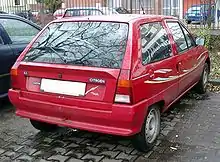Citroën AX
The Citroën AX is a supermini which was built by the French manufacturer Citroën from 1986 to 1998. It was launched at the 1986 Paris Motor Show to replace the Citroën Visa and Citroën LNA.
| Citroën AX | |
|---|---|
 | |
| Overview | |
| Manufacturer | Citroën |
| Also called | Proton Tiara |
| Production | 1986–1998 (2,425,138 units) |
| Assembly | France: Rennes (PSA Rennes Plant) Spain: Vigo (PSA Vigo Plant) Yugoslavia: Koper (Cimos)[1] |
| Body and chassis | |
| Class | Supermini (B) |
| Body style | 3-door hatchback 5-door hatchback |
| Layout | Front-engine, front-wheel-drive/four-wheel-drive |
| Powertrain | |
| Engine | 1.0 L I4 (petrol) 1.1 L I4 (petrol) 1.3 L I4 (petrol) 1.4 L I4 (petrol) 1.6 L I4 (petrol) 1.4 L I4 (diesel) 1.5 L I4 (diesel) 11 kW/15 hp (electric) |
| Transmission | 4-speed manual 5-speed manual |
| Dimensions | |
| Wheelbase | 2,280 mm (89.8 in) |
| Length | 3,525 mm (138.8 in) |
| Width | 1,555 mm (61.2 in) |
| Height | 1,355 mm (53.3 in) |
| Curb weight | 640–850 kg (1,411–1,874 lb) |
| Chronology | |
| Predecessor | Citroën LNA Citroën Axel Citroën Visa |
| Successor | Citroën Saxo |
Overview



Development of this model started in 1983, and was initially also going to form the basis of a sister model from Talbot to replace the Samba; however, the falling popularity of the Talbot brand - coupled with the huge success of the new Peugeot 205 - had led to Peugeot deciding to axe it by the time the Citroën AX was launched, and so the Talbot version never made it into production.[2]
The car was available on the left-hand drive continental markets from its launch on 2 October 1986,[3] as a three-door hatchback with 1.0, 1.1 and 1.4-litre TU-series belt driven OHC engines. A range of five-door models was added in 1987 and a 1.4 litre diesel engine was introduced in 1988. The latter was replaced by a 1.5 litre unit in September 1994. The right-hand drive version for the UK market was launched in August 1987, initially only as a three-door hatchback, with a five-door version joining the range a year later, effectively replacing the five-door Citroën Visa, which was discontinued that year. With the final demise of the classic Citroën 2CV in 1990, the AX became the smallest model in the Citroën range.[4] The very earliest cars had an issue with gear shifters falling off; this was rectified by the time the AX reached export markets.[5] It was initially backed by a memorable television advertising campaign filmed in China, starring actress Janet Mas and an elderly gentleman, whose character was simply known as Mr. Wong.

The car was very economical, largely because of excellent aerodynamics for its class of car (drag coefficient of 0.31) and a very light weight of 640 kg (1,411 lb) for the basic version.[5] This was due to the extensive use of plastic panels in non-load bearing areas and varying the thicknesses of steel in the bodyshell to be the minimum needed to take required loads. Another target for the engineers was lowering friction in the engines.[5] The AX has fully independent suspension with unusually long wheel travel.
It also optionally used self-coloured plastic bumpers. This technology came from the PSA Peugeot-Citroën / Renault / French government ECO 2000 project.[6] The production version was much more conservative than the original 'one box' design prototype, that was closer to the Eco 2000 styling after negative reactions in focus groups.[7] The "one-box" city car eventually came to market with the Renault Twingo, launched in 1992.
In 1989, a naturally aspirated diesel AX, using the 1360 cc all aluminium alloy TUD engine, managed a figure of 2.7 litres per 100 kilometres (100 mpg‑imp; 87 mpg‑US), totalling over 1,000 miles (1,609 km) from Dover to Barcelona. This was the longest ever distance travelled on 10 imp gal (45.5 L; 12.0 US gal) of fuel and earned it a place in the Guinness Book of Records as the most economical production car. Also available was a 4x4 variant,[8] but with limited success when compared to the rival Fiat Panda 4x4. The AX 4x4 was only available with five doors and was not sold in the United Kingdom.
The first performance version was the limited-run AX Sport from 1987, with a 1.3 engine and twin carburettors producing 95 bhp (71 kW; 96 PS), wearing iconic white steel wheels (5,5" x 13") which resembled those on its brother, the Peugeot 205 Rallye. The AX Sport used Solex ADDHE 40 carburettors until late 1988 and was then replaced with Weber DCOM 40s, just like the 205 Rallye 1,3. The AX Sport had a shorter inlet manifold than the 205 Rallye, to save room in the smaller engine compartment. In phase 2 guise the Sport was available in other colours and with optional GT wheels and rear spoiler.
Later, the AX 14GT, with a single-carburettor 85 bhp (63 kW; 86 PS) 1.4 engine also found in the Peugeot 205 XS, was introduced. From 1991, this model utilised fuel injection to coincide with the revamp of the entire range and to coincide with tougher 1992 EU emission regulations that introduced exhaust catalytic converters.
Facelift


Late 1991 saw the range revised, with a heavily facelifted tailgate and interior being the most notable changes. The front turn signals were now clear, and the Citroën logo was moved to the center of the bonnet. The much maligned dashboard was replaced by a more conservative design.
The following year saw the introduction of the most powerful AX variant, the 100 bhp (75 kW; 101 PS) GTi. The GT was sold alongside the GTi for a few months, but was eventually phased out. New models were also introduced, such as the Forte, Spree, Elation and Dimension.
In January 1995, the Citroën AX Echo was launched, with a top speed of 110 mph (180 km/h). Its closest competitor, the Peugeot 106 Ski, (that shared components with the AX), was outsold by the Echo. From June 1996, following the introduction of the Saxo, the range was slimmed-down, with production of the AX ending in December 1998, after a 12-year production run. It had been withdrawn from the UK market during the first half of 1997, following the demise of right-hand drive production. A total of 2,425,138[9] AXs were produced.
The Peugeot 106 (launched in 1991) and Citroën Saxo were both developments of the AX. They followed the 1990s trend for heavier, more solid and 'safer' feeling cars that continues today. The AX was designed for lightness, with a 'less is more' philosophy, but with more conventional styling than previous Citroëns.
Derivatives
_Cabriolet.jpg.webp)
_Ranch_(vue_avant_droit).jpg.webp)
In 1996, the EV3 engine (air engine) was mounted into a regular Citroën AX car by MDI. Heuliez presented an estate version called the AX Evasion at the 1988 Mondial de l'Automobile.
Besides the well known versions that are documented Citroën also produced a few rare variants.
Based on the AX Citroën build a concept car named Xanthia.
Citroën produced a number of 374 AX Electriques starting December 1993 to 1996.
An unknown number of GTi badged "ZADM" cars were equipped with a Française de Mécanique (Douvrin) 1.6 liter 16 valves engine that produce 118hp and were rebadged to GTi 16 Soupapes, these were produced at the end of production years. Based on this factory version, many conversions were made by enthusiasts utilizing TU5J4 engines from either the Citroën Saxo or Peugeot 106 or TU5JP4 from various other models.
A turbo version was proposed by Mr. Danielson in the 90s, producing 173 PS - 170 hp, but it is unclear if this ever left the prototype phase.

The Citroën AX BB Cabrio was a small roadster derived from the AX (1988). In Portugal, Citroën dealership Benjamin Barral from Amadora in Lisbon created an unofficial convertible version in the 1980s until about 1996 called the BB AX Cabrio, originally powered by the twin-choke carb AX GT 1.4 L engine, but later available with any type of engine that equipped the 3 door AX.
At one stage, parent firm PSA Peugeot Citroën had planned to launch a Talbot Samba replacement as a version of the AX with a different grille and a Talbot badge, but this plan was cancelled, as the entire Talbot marque was axed on passenger cars by 1987 following several years of declining sales.
Automobiles Citroën also launched the AX Pistes Rouges 4WD 1400 model, based on the standard three-door AX GT 1360cc engine but with a unique four-wheel-drive system developed and produced by the French Dangel company for between 1992 and 1994.
Malaysian car company Proton produced a version of the Citroën AX, the Proton Tiara, from 1996 to 2000.
Aixam Mega at one time built an AX derivative called Mega Club and Mega Ranch. It was somewhat inspired by the Méhari, with a plastic bodywork and an optional convertible version, with two-wheel drive or four-wheel drive. It was discontinued in 1998, after nearly 1,000 had been built. A competition version of the Mega Club with a tubeframe chassis raced in the Andros Trophy in the early 1990, but powered by Ford and Honda engines.
Models
| VDS | Model | Production |
|---|---|---|
| ZAZA | AX 10 E | 1986–1990 |
| ZAZA | AX Ten | 1991 - UK |
| ZAZA | AX 10 RE | 1987–1989 |
| ZAZB | AX 10 RE | 1987–1988 |
| ZALH | AX 10 | 1992 - UK |
| ZAZB | AX 11 RE | 1988–1990 |
| ZAZB | AX 11 TE | 1990–1991 |
| ZAZB | AX 11 TGE | 1990–1991 |
| ZAZB | AX 11 TRE | 1987–1989 |
| ZAZB | AX 11 TRS | 1990–1991 |
| ZAZA | AX 11 | 1992–1994 |
| ZAZP | AX 11 | 1994 - UK |
| ZADA | AX 11 | 1994–UK |
| ZAZC | AX 11 | 1994–UK |
| ZAZC | AX 14 TRS | 1987–1990 |
| ZAZC | AX 14 TZX | 1991–1991 |
| ZADD | AX 14 | 1992–1994 |
| ZAZD | AX 14 | 1992–1994 |
| ZAZD | AX GT | 1988–1992 |
| ZADD | AX 14 GT | 1992–1994 |
| ZAZW | AX GT | 1994 - UK |
| ZADN | AX GTi | 1991–1992 |
| ZADM | AX GTi | 1992 - UK |
| ZALB | AX 4x4 | 1991–1992 |
| ZALF | AX 4x4 | 1992 - UK |
| ZAZL | AX Sport | 1987–1991 |
| ZAZA | AX K-Way | 1988–1991 |
| ZAZA | AX Spot | 1991–1991 |
| ZAZB | AX Image | 1991–1991 |
| ZAZB | AX Thalassa | 1991–1991 |
| ZAZD | AX Volcane | 1991–1991 |
| ZAZT | AX 14 D | 1990–1991 |
| ZAZT | AX 14 RD | 1989–1990 |
| ZAZT | AX 14 TGD | 1991–1992 |
| ZAZT | AX D | 1992–1994 |
| ZADF | AX 14 D | 1994 - UK |
| ZAKH | AX 15 D | 1994 - UK |
| ZAZH | AX 10 E | 1988–1989 |
| ZAZH | AX 10 RE | 1988–1993 |
| ZAZH | AX Ten | 1991–1993 |
| ZALJ | AX 10 | 1992 - UK |
| ZAZJ | AX 11 TGE | 1990–1991 |
| ZAZJ | AX 11 RE | 1988–1989 |
| ZAZJ | AX 11 TE | 1990–1991 |
| ZAZJ | AX 11 TRE | 1988–1989 |
| ZAZJ | AX 11 TRS | 1990–1991 |
| ZADB | AX 11 | 1992–1994 |
| ZAZ5 | AX 11 | 1994 - UK |
| ZAZB | AX 11 | 1994 - UK |
| ZAZK | AX 11 | 1994 - UK |
| ZAZK | AX 14 TRS | 1988–1990 |
| ZAZK | AX 14 TZS | 1988–1989 |
| ZAZK | AX 14 TZX | 1991–1991 |
| ZAZE | AX 14 | 1992–1994 |
| ZAZY | AX 14 | 1994 - UK |
| ZAZX | AX 14 | 1994 - UK |
| ZAZY | AX GT | 1990–1992 |
| ZADE | AX GT | 1992–1994 |
| ZAZY | AX 14 | 1994 - UK |
| ZAZX | AX 14 | 1994 - UK |
| ZAZY | AX GT | 1990–1992 |
| ZADE | AX GT | 1992–1994 |
| ZAZU | AX 4x4 | 1991–1992 |
| ZALG | AX 4x4 | 1992 - UK |
| ZAZH | AX K Way | 1988–1991 |
| ZAZJ | AX Image | 1991–1991 |
| ZAZJ | AX Thalassa | 1991–1991 |
| ZAZU | AX 14 D | 1989–1991 |
| ZAZU | AX 14 RD | 1989–1990 |
| ZAZU | AX 14 TRD | 1989–1991 |
| ZAZU | AX 14 TGD | 1991–1991 |
| ZAZU | AX 14 D | 1992–1994 |
| ZADG | AX 14 D | 1994 - UK |
| ZAKJ | AX 15 D | 1994 - UK |
| ZAZU | AX Image D | 1991–1991 |
| ZAZU | AX Thalassa D | 1991–1991 |
References
- SFRJ četvorotočkaši: Šta su pravili i vozili Jugosloveni? at ba.n1info.com, 23-12-2015
- "Citroen based Samba replacement". Rootes-Chrysler.co.uk. Retrieved 1 August 2011.
- "The mood of car firms in France on upswing". Pqasb.pqarchiver.com. 11 October 1986. Retrieved 1 August 2011.
- Citroën AX 1986 - 1988, www.citroenet.org.uk Retrieved 1 May 2016
- Collin, Robert (15 April 1987). "Citroën AX: Smakligt småfranska" [Tasty french bread roll]. Teknikens Värld (in Swedish). Stockholm, Sweden: Specialtidningsförlaget AB. 39 (9): 9.
- "ECO 2000 - Citroenet". Retrieved 7 January 2010.
- "Citroën S9 - AX prototypes - Citroënet". Retrieved 7 January 2010.
- Car: Citroën AX 4x4 at fullworld.eu
- "History". Citroen AX .Net. 25 July 2011. Archived from the original on 12 October 2011. Retrieved 1 August 2011.